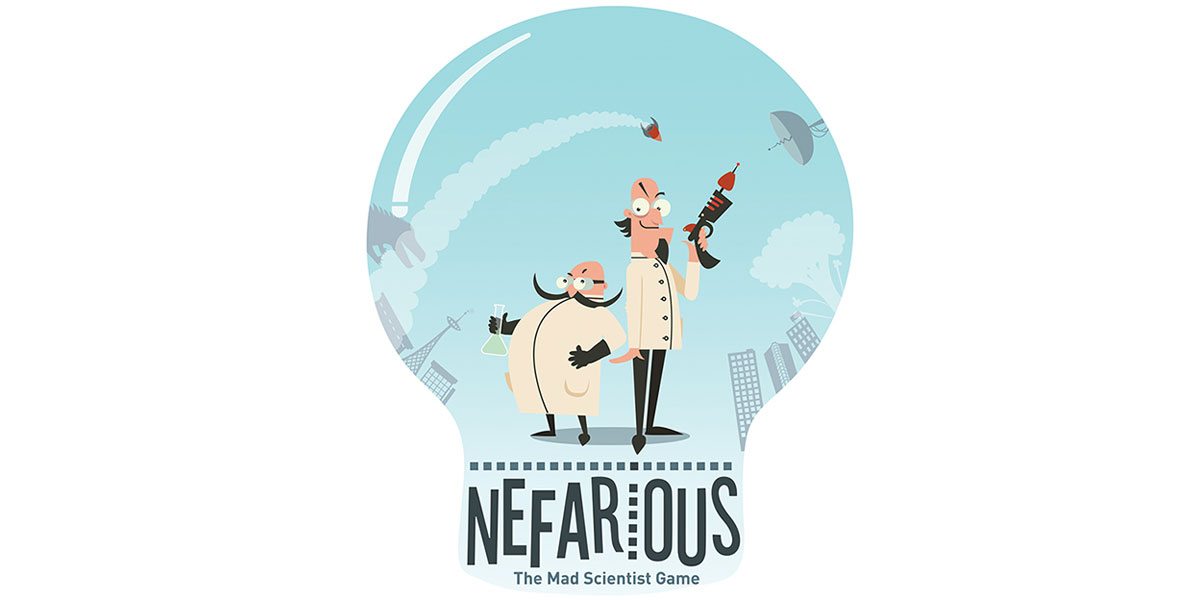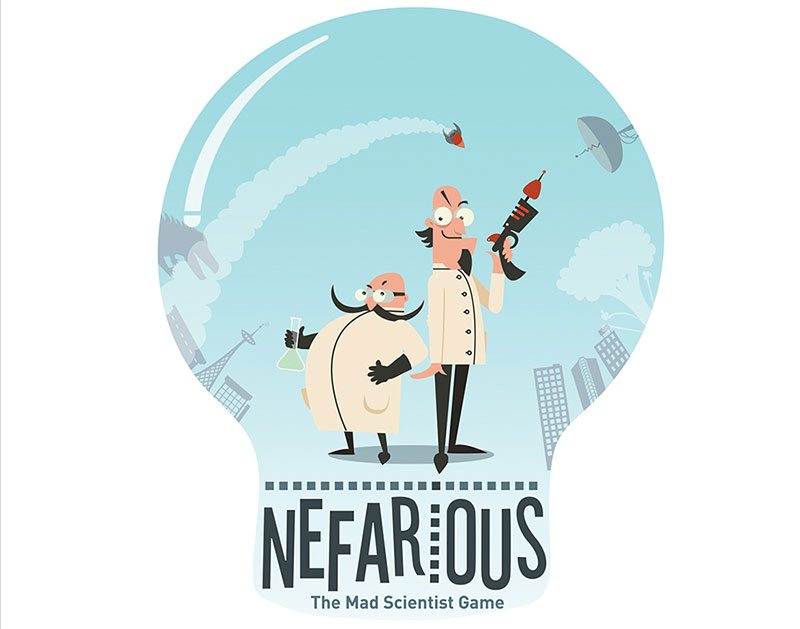They thought I was mad, but wait until they see the effects of my Death Ray! Too cliched? How about this Doomsday Machine? Still not impressed? Maybe my Universal Solvent will do the trick. Just you wait–the world will be mine soon! Or perhaps yours. It all depends on who is the most Nefarious.
At a glance: Nefarious is a game by Donald X. Vaccarino for 2 to 6 mad scientists, ages 13 and up, and takes 20-40 minutes to play. It retails for $29.95 and is in stores now. I would say you could play with younger players who have some gaming experience–the rules are pretty straightforward and there isn’t anything inappropriate in the content.

Components:
- Game board
- 30 Spy figures (5 each in 6 colors)
- 36 Twist cards
- 64 Invention cards
- 24 Action cards (4 each for 6 players)
- 90 Coin tokens (in $10, $5, and $1 denominations)
The artwork is nice–I like the little mad scientist characters on the box, who make appearances throughout the invention cards. The iconography for the invention effects isn’t immediately intuitive, but once you’ve gotten an explanation it’s fairly easy to decipher. The one complaint about the visuals is that the colors of the action cards for “Work” and “Invent” are pretty close to each other (one is slightly purple-ish blue, and the other is slightly green-ish blue) and at a glance it’s easy to misread somebody’s card.
The components overall look nice but feel a little flimsy. When I punched the cardboard coin tokens out, I had a few where the plastic-like layer didn’t want to detach and peeled away, and there’s at least one coin where the printed layer completely fell off the cardboard during the first play. The cards are very thin and feel floppy. The Twist cards are extra-large, and the rest of them are standard sized. I’ve seen other complaints about the component quality–cards that weren’t cut properly and weird printing problems–but I haven’t encountered that myself.
Nefarious was originally published in 2011 by Ascora Games but there were some production issues and availability was limited. When the company went out of business, the rights reverted back to Vaccarino, and USAopoly released a new version this year. If you’re curious about how the two versions compare, I’ve got some photos on the next page.
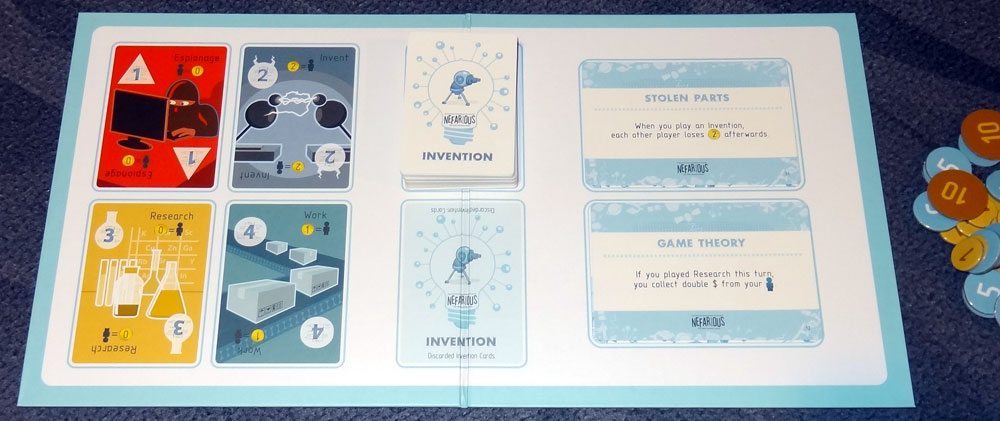
How to play
The goal of the game, of course, is to take over the world. Failing that, reaching 20 points is a decent fallback.
To set up the game, put the board in the center of the table, shuffle the Twist cards, and randomly choose two of them to place on the board face-up. Some Twists may affect setup. The rest of the Twist cards are placed back into the box.

Each player gets 5 spies and 4 Action cards of the same color, as well as $10 and 3 Invention cards. (Invention cards are kept secret; money is public information.) The rest of the Invention cards are placed on the board.
Play in Nefarious is simultaneous, rather than turn-based. Each round of play, everyone chooses one of their four Action cards to play (face-down). When everyone is ready, the cards are revealed. First, everyone collects income from spies, and then the actions are resolved in numerical order.
Collecting income: Each spy that you have on the board (you won’t have any the first turn) earns you $1 from the bank whenever a player adjacent to you chooses the action your spy is on. So, if you have two spies on “Invent” and the player to your left chooses “Invent,” you’ll earn $2 from the bank.
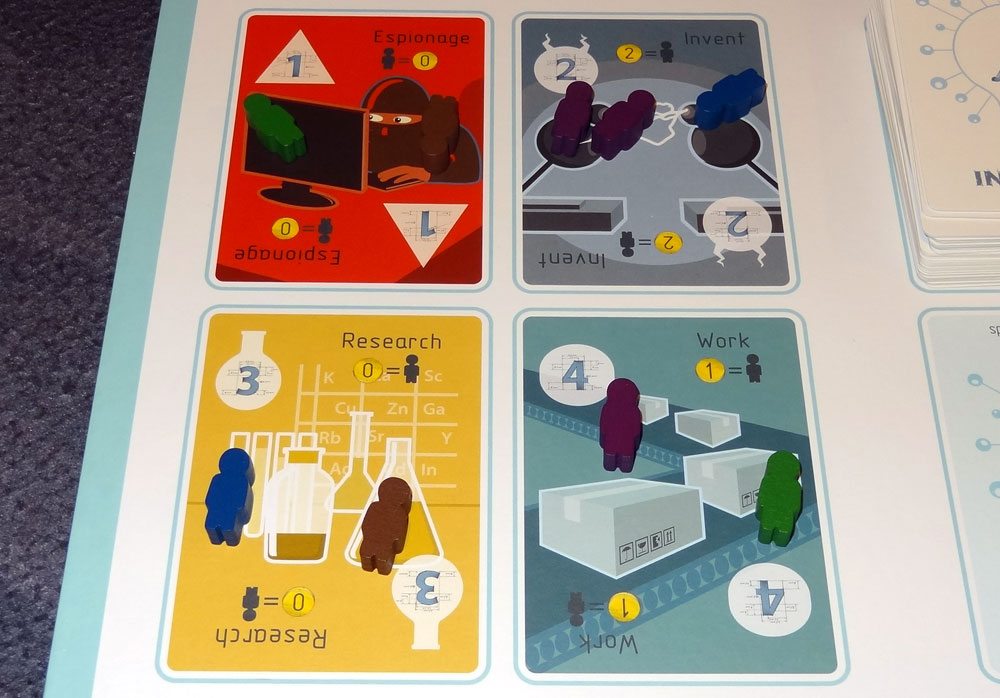
Resolving actions:
- Espionage: Place a spy on one of the four action spaces on the board, paying its cost to the bank.
- Invent: Choose an Invention card from your hand and place it face-down. Once all inventing players have chosen, Inventions are revealed–pay the cost of the invention to the bank. (If you can’t afford it, put it back into your hand.) Then the Invention effects trigger–some affect other players, some affect you, some do both. Finished Inventions stay in front of you for the rest of the game and are worth points.
- Research: Draw an Invention card and take $2 from the bank.
- Work: Take $4 from the bank.
Once all four actions have been resolved, everyone picks up their used Action card and the round begins again.
At the end of a round, if any player has at least 20 points and has more points than everyone else, that player wins. Otherwise, continue playing.
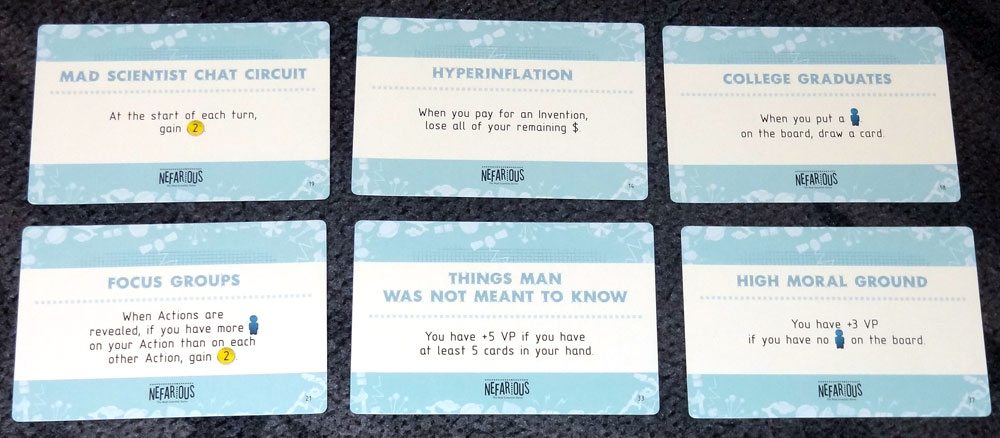
That’s basically the whole game. Inventions have varying costs, effects, and point values. The Twists change up the game rules each time you play, and some are simpler than others. For instance, “Propaganda” just increases the value of all inventions by 1 point. “Embezzling Minions” makes you discard down to the nearest $5 if you have more than $5 at the beginning of your turn. “Age of Boredom” prevents you from playing the same Action twice in a row. Since the Twists are global and affect everyone, they don’t confer any advantages, but they mix things up for more variety.

The Verdict
Nefarious is a pretty fast-paced game with little downtime. Hey, taking over the world doesn’t leave much time for sitting around twiddling your thumbs. Since actions are chosen simultaneously and resolved in groups, the game keeps moving. On top of that, the actions are mostly quick to resolve, too: Research and Work are just about drawing cards and getting money from the bank, so there’s no real downtime at all for those. The longest one to resolve is the Invent action, mostly in taking care of the effects after somebody has built something.
Since the object of the game is to get points, the flow of the game is straightforward: figure out how to get income, build inventions, repeat. Placing your spies with Espionage is a handy way to generate ongoing income if you can predict what your opponents will be doing. If you have spies on the board, you can even gamble on choosing Invent when you don’t have enough money on hand, because you might get some money before you have to pay for it.

The Inventions themselves have a variety of effects, but they’re basically some combination of: draw or discard cards, get or lose money, place or remove spies on the board. There’s a balance between the cost of an invention, its effects, and its point value. Some inventions may help you a lot but don’t give you many points. Some may give you a lot of points but no effect (or even a detrimental effect). You can decide whether it makes more sense to build fewer inventions that are worth more points, or whether to build a whole bunch of cheap inventions. (And your decision may be influenced by whether your opponents have put spies on “Invent.”)
The inventions themselves, while they have fun names and illustrations, don’t always feel thematically tied to their effects. Like, why does the Cloning Machine give everyone else a spy? Why does the Moon Base make you discard all your own cards? On the other hand, there are some that do seem to make sense: Delicious By-products gives you a coin per invention you own; the Paralyzing Ray makes everyone else remove a spy from the board. Many of the inventions, though, simply have no effect whatsoever and are only worth points.
The game can be a lot of fun, but I do think you have to add a bit of your own flavor to the theme. “Work” is not a very flavorful way to get money–you’d think maybe you should be robbing a bank or something, right? It helps if everyone works on their maniacal laughs for when they complete an invention, or maybe talk like Gru all the time.
The Twists do add a lot of variety to the game–with 36 Twist cards, chances are slim that you’ll end up with the exact same combination even after dozens of plays. Some Twists are certainly easier to resolve than others, and you’ll probably have your favorites. The one warning is that Twists can have an affect on the length of the game–for instance, if you get the Twist that increases the goal to 30 points and the one that prevents you from getting money for Research, then it will make the game longer. On the other hand, there are other combinations that could make it easier to get money and inventions, which means you spend more time inventing and less time acquiring money.
Overall, I think Nefarious is a fun game that has some amount of strategy but won’t overwhelm casual gamers. The mad scientist theme is fun but isn’t always deeply integrated, and the components are visually appealing but the quality leaves something to be desired. The USAopoly edition finally makes it possible to get a copy of Nefarious at a reasonable price.
In short: Will you feel Gru when you play this game? Maybe, but you’ll have to bring some of that to the table yourself.
Disclosure: GeekDad received a review copy of this game.
